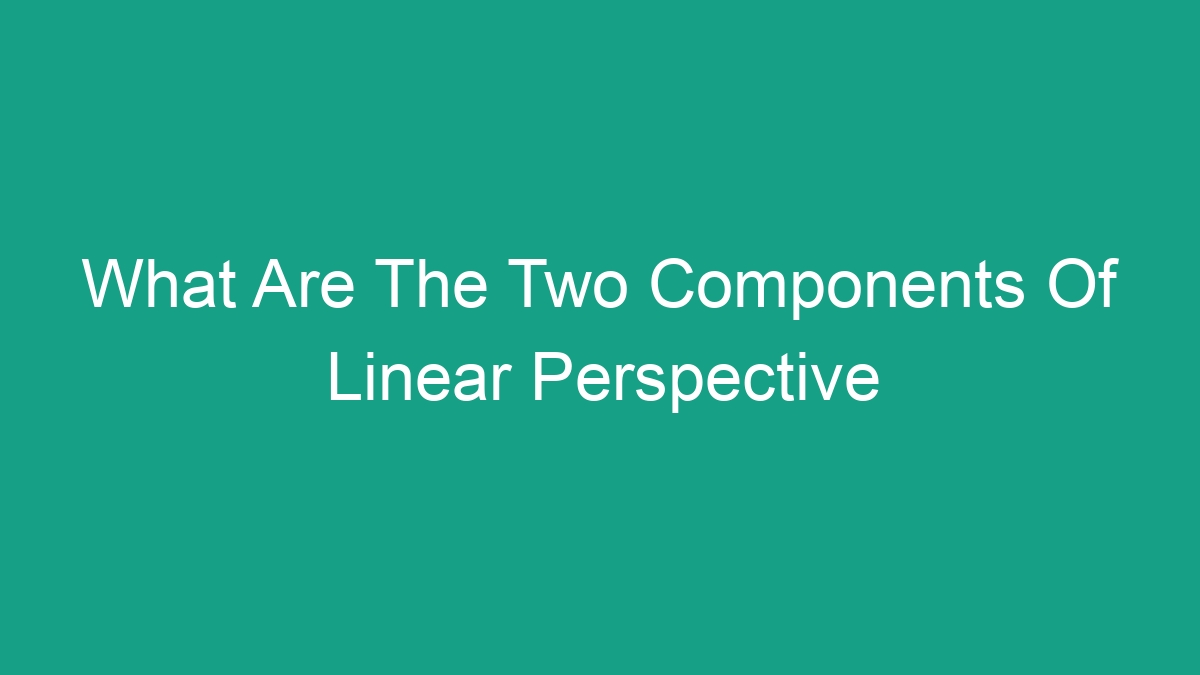
Introduction to Linear Perspective
Linear perspective is a crucial concept in art and architecture that allows artists and designers to create realistic depictions of three-dimensional space on a two-dimensional surface. This technique dates back to the Renaissance period and has since been widely used in various artistic and architectural disciplines. At its core, linear perspective is based on the concept of converging lines and vanishing points, which are made up of two essential components.
1. Vanishing Points
The first component of linear perspective is vanishing points. In a two-dimensional representation of a three-dimensional scene, vanishing points are the points on the horizon line where parallel lines appear to converge or “vanish.” These points are crucial in creating the illusion of depth and distance in a painting or drawing. When an artist establishes vanishing points in their composition, they can use them as a reference to accurately depict the diminishing scale of objects as they recede into the distance.
Understanding The Role of Vanishing Points
Vanishing points serve as the anchor for the entire structure of linear perspective. They determine how objects and architectural elements are positioned and scaled within a composition. By establishing vanishing points, artists can create a sense of depth, proportion, and spatial relationships within their work, ultimately leading to a more convincing and realistic representation of the scene.
Types of Vanishing Points
There are different types of vanishing points that artists can use to achieve varying effects in their work. The most common types include:
- One-Point Perspective: In one-point perspective, all parallel lines converge at a single vanishing point on the horizon line. This technique is often used for compositions with a frontal view of objects, buildings, or interiors, creating a strong sense of depth.
- Two-Point Perspective: Two-point perspective involves two vanishing points on the horizon line, where orthogonal lines converge. This technique is commonly used for depicting architectural scenes and environments with receding planes and surfaces.
- Multi-Point Perspective: Multi-point perspective utilizes three or more vanishing points to represent complex spatial structures and angles, often seen in urban landscapes and intricate architectural compositions.
2. Orthogonal Lines
The second component of linear perspective is orthogonal lines. Orthogonal lines are imaginary lines that radiate from the eye of the viewer to the vanishing points on the horizon line. These lines establish the visual relationships and proportional accuracy within the composition, guiding the placement and scale of objects in the scene. By using orthogonal lines, artists can create a visual roadmap for accurately positioning elements in space and maintaining proper perspective.
The Importance of Orthogonal Lines
Orthogonal lines form the framework for constructing the geometric underpinnings of a composition. They enable artists to align objects and architectural elements with the vanishing points, ensuring that the angles and proportions remain consistent throughout the artwork. This systematic approach allows for precise representation of spatial depth and perspective, enhancing the realism and believability of the final piece.
Application of Orthogonal Lines in Art and Architecture
Whether in painting, drawing, or architectural design, orthogonal lines play a critical role in achieving accurate spatial representation. Artists and architects use orthogonal lines to construct grids, determine the placement of elements, and establish the overall sense of scale and depth within their compositions. This methodical approach provides a solid foundation for creating visually compelling and immersive depictions of three-dimensional space.
Conclusion
In conclusion, the two components of linear perspective–vanishing points and orthogonal lines–are essential tools for creating the illusion of depth and spatial accuracy in art and architecture. By understanding the principles of linear perspective and mastering its components, artists and designers can elevate their work to new levels of realism and immersive visual impact.
FAQs
Q: How does linear perspective enhance the visual impact of a composition?
A: Linear perspective creates the illusion of depth and spatial relationships, allowing for a more realistic and immersive representation of the scene. This enhanced sense of depth draws viewers into the artwork or architectural design, making it visually captivating and dynamic.
Q: Is linear perspective limited to a specific style or artistic movement?
A: Linear perspective is a fundamental principle that transcends artistic styles and movements. It is a timeless technique that continues to be utilized by artists and designers across various disciplines to achieve spatial accuracy and visual impact in their work.



